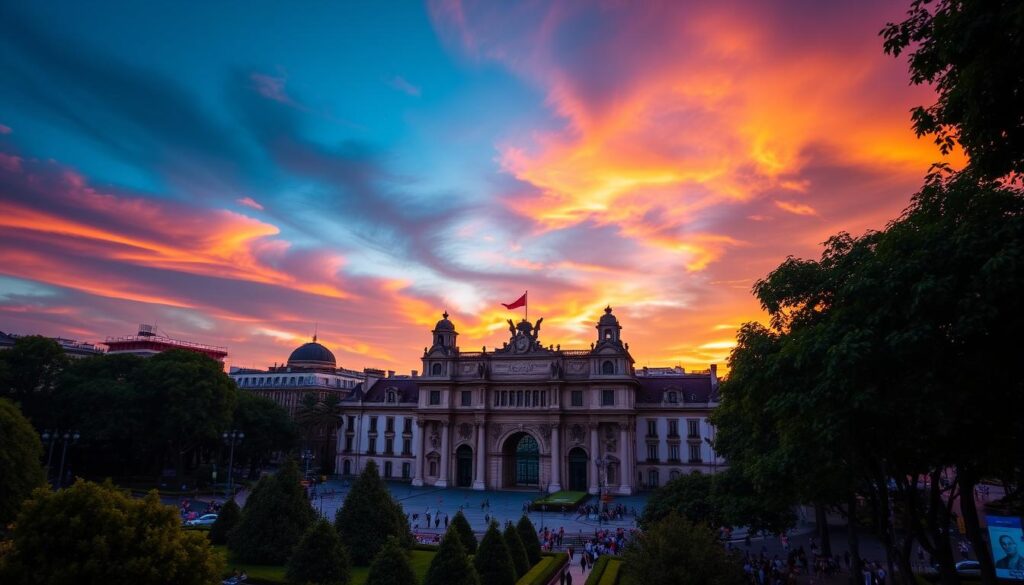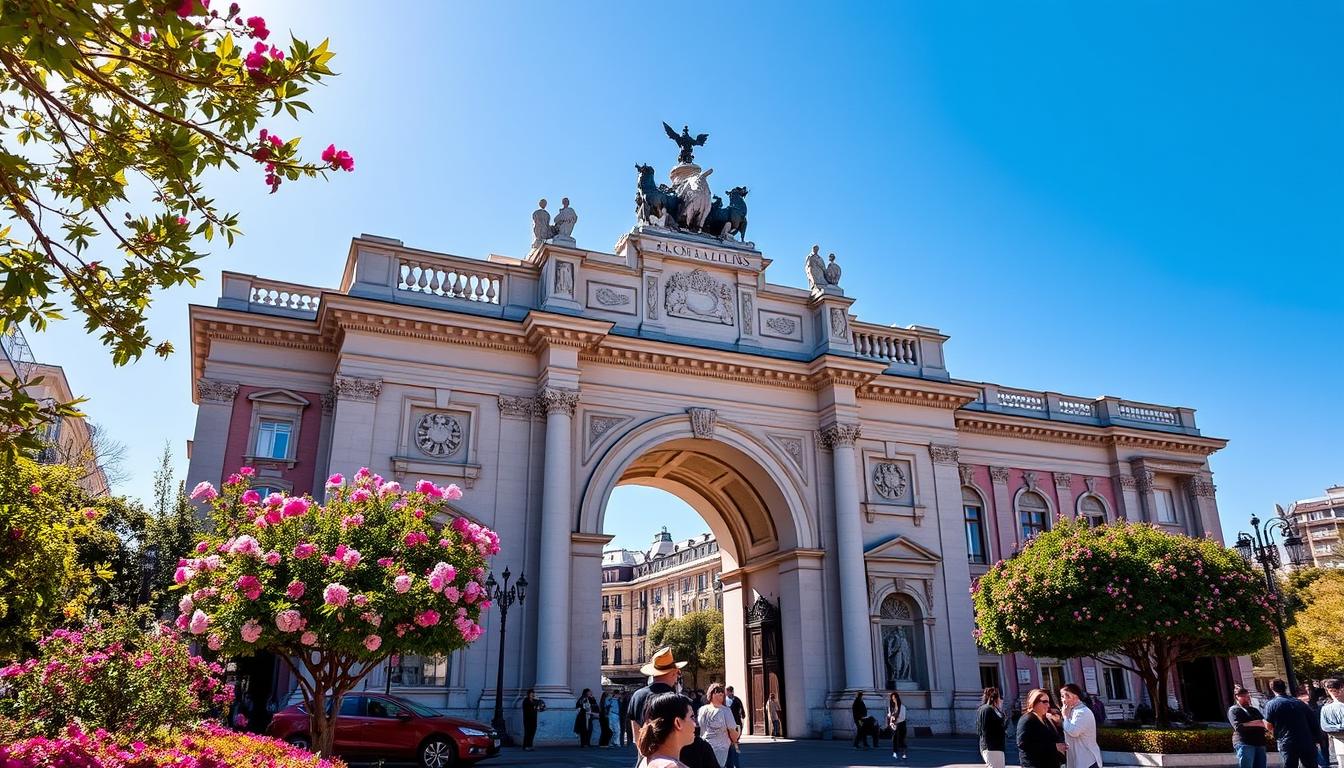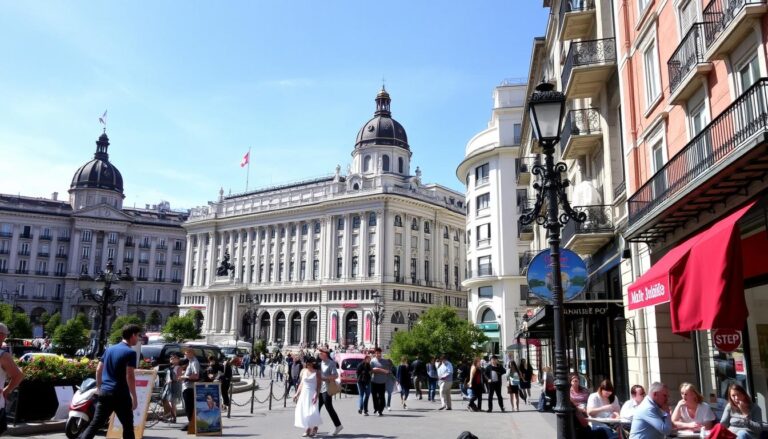Explore the Iconic Puerta de Alcala in Madrid
When you enter Madrid, the Puerta de Alcala greets you with its beauty. This landmark is a key part of the city’s history. It draws you in with its stunning neoclassical design, telling stories of the past.
The Puerta de Alcala is more than a gate. It’s a gateway to Madrid’s lively history and today’s culture. Located in Plaza de la Independencia, it symbolizes the city’s strength and heritage. It’s a place where history meets today, offering a unique experience for all visitors.
Close to Parque del Buen Retiro, this neoclassical gem invites you to see its fine details. It’s a key spot in Madrid’s architecture and culture. As more tourists visit Madrid in 2023, the Puerta de Alcala remains a highlight.
Table of Contents
Introduction to Puerta de Alcala
Madrid’s architecture is filled with history, and the Puerta de Alcalá is a key part of it. This iconic spot draws visitors from all over, showing off Spain’s 18th-century architectural skills.
Historical Significance
The Puerta de Alcalá was finished in 1778. It’s a major triumphal arch in Europe. King Carlos III built it, making it a symbol of Madrid’s history.
This gate is a turning point in Madrid’s growth. It connects the city’s past to its lively present.
- Commissioned by King Carlos III
- Completed in 1778
- Stands 19 meters high
- Located at Plaza de la Independencia
Architectural Style
The Puerta de Alcalá’s design is neoclassical, thanks to Italian architect Francesco Sabatini. Its beauty shows off the 18th century’s artistic vision. It mixes detailed sculptures with big architectural parts, still amazing people today.
| Architectural Feature | Description |
|---|---|
| Design Style | Neoclassical |
| Architect | Francesco Sabatini |
| Height | 19 meters |
| Material | Stone |
Location and Accessibility
The Puerta de Alcalá is in Madrid’s heart, easy for visitors to find. It’s near Retiro Park, a must-see for those exploring the city’s history. Though traffic limits getting close, it’s still a stunning sight from many angles.
- Adjacent to Retiro Park
- Located at Plaza de la Independencia
- Illuminated at night for enhanced viewing
- Easily accessible by public transportation
A Brief History of Puerta de Alcala
The Puerta de Alcalá is a key part of Spain’s architectural history. It’s not just a landmark; it’s a symbol of Madrid’s growth. It shows the city’s cultural journey.
Construction and Design
In 1774, King Charles III started the Puerta de Alcalá. It was finished in 1778. This was a big moment in Spanish architecture.
It was the first triumphal arch in Europe since the Roman Empire. It has:
- Five arches that show off neoclassical design
- Details that celebrate royal virtues
- Decorations that show off royal power
Restoration Efforts
Keeping the Puerta de Alcalá safe has been a big goal. Many restoration projects have helped. They’ve kept the monument strong and true to its past. Important moments include:
- 1869: The Plaza de la Independencia was made around it
- 1976: It was officially named a national monument
- Today, there are ongoing efforts to keep its details safe
Cultural Importance
The Puerta de Alcalá is more than just a building. It shows Madrid’s heart and soul. In Charles III’s time, it was a sign of new ideas and royal strength.
Today, it’s a top spot for those exploring Spain’s history. It’s a key part of Spain’s cultural identity.
| Historical Milestone | Year |
|---|---|
| Construction Initiated | 1774 |
| Completed | 1778 |
| National Monument Status | 1976 |
Visiting Puerta de Alcala
Planning your visit to this iconic tourist attraction requires some strategic thinking. The Puerta de Alcalá stands as a magnificent travel destination in the heart of Madrid’s Salamanca district. It offers visitors a unique historical experience.
Best Times to Visit
To maximize your experience at this remarkable landmark, consider these optimal visiting periods:
- Early morning (7-9 AM) for soft lighting and fewer crowds
- Late afternoon (4-6 PM) for golden hour photography
- Weekdays for less tourist congestion
- Spring and autumn for mild temperatures
Nearby Attractions
The Puerta de Alcalá is perfectly situated near several world-renowned sites:
| Attraction | Distance | Walking Time |
|---|---|---|
| El Retiro Park | 100 meters | 2 minutes |
| Museo Nacional del Prado | 500 meters | 7 minutes |
| Cibeles Fountain | 300 meters | 4 minutes |
| Thyssen-Bornemisza Museum | 600 meters | 8 minutes |
Accessibility Options
Your visit to this historic landmark can be convenient and comfortable with multiple transportation choices:
- Metro: Line 2 (Banco de España station)
- Bus: Multiple routes stop nearby
- Walking accessibility from city center
- Wheelchair-friendly surrounding paths
Whether you’re a history buff or a casual traveler, the Puerta de Alcalá promises an unforgettable experience in the heart of Madrid.
Architectural Features of Puerta de Alcala
The Puerta de Alcala is a stunning neoclassical monument from 18th-century Madrid. It was designed by Francesco Sabatini for King Charles III. This iconic structure is a highlight of architectural excellence in the Spanish capital.
Neoclassical Design Elements
The Puerta de Alcala is a true neoclassical gem. It has unique architectural features that make it stand out. The gate’s design includes:
- Symmetrical proportions
- Elegant marble columns
- Precise geometric lines
- Classical architectural principles
Symbolic Inscriptions
The Puerta de Alcala is more than just a building. Its inscriptions tell stories of history. They celebrate the achievements of King Charles III and the Spanish monarchy.
Sculptural Details
The gate is adorned with exceptional sculptures. Intricate masks, detailed reliefs, and symbolic sculptures tell stories of Madrid’s culture. Each element adds to the gate’s beauty.
There are two facades with different themes. One shows sculptures of four virtues. The other has symbols like weapons and breastplates. This makes Puerta de Alcala a masterpiece of neoclassical design.
Events and Celebrations at Puerta de Alcala
Madrid’s Puerta de Alcala is a hub for exciting events all year. It shows off the city’s culture and modern vibe. This historic spot is perfect for celebrating local traditions and new experiences.
Madrid’s event calendar is filled with celebrations that show off the city’s spirit. From traditional festivals to fashion events, Puerta de Alcala is key to these moments.
New Year’s Eve Celebrations
At midnight, Puerta de Alcala is the heart of Madrid’s New Year’s Eve. Thousands gather for:
- Festive countdown celebrations
- Live music performances
- Spectacular fireworks displays
- Traditional grape-eating ritual
National Holidays
On national holidays, the landmark is a symbol of Spanish pride. Key events include:
- Community of Madrid Day (May 2)
- Three Kings Day Parade (January 5)
- San Isidro Festival celebrations
Cultural Festivals
Some top events near Puerta de Alcala are:
- Mercedes-Benz Fashion Week Madrid (February 14-18)
- Madrid Design Festival (February 12-23)
- LGBTIQA+ Pride festivities
- Madrid es Moda fashion event (September 7-11)
The Madrid es Moda event is especially notable. It turns Puerta de Alcala into a runway. On September 7th, it features fifty models and over 30 designers, celebrating Spanish fashion.
Photography Tips for Your Visit
Capturing the Puerta de Alcalá’s beauty needs careful planning and creativity. As a top spot in Madrid, it offers many chances to take amazing photos.

Exploring this place can turn a simple photo into something truly special.
Best Angles and Perspectives
Start by understanding the monument’s layout. Here are some key views to try:
- Front-facing shot capturing architectural details
- Diagonal angle showcasing sculptural elements
- Wide-angle view including Plaza de la Independencia
- Close-up shots highlighting intricate designs
Optimal Times for Lighting
Lighting can make your photos of this landmark even better:
- Golden Hour: Early morning or late afternoon for soft, warm light
- Twilight: Dramatic lighting on the architecture
- Midday: Clear details with strong shadows
- Night: Magical lighting on the architecture
Recommended Equipment
| Camera Type | Recommended Lens | Best Use |
|---|---|---|
| DSLR | Wide-angle 16-35mm | Comprehensive architectural shots |
| Mirrorless | 24-70mm zoom | Flexible framing options |
| Smartphone | Ultra-wide lens attachment | Casual tourist photography |
Pro tip: Use a lightweight tripod for stable night shots. Also, consider a polarizing filter to reduce glare and highlight details.
Puerta de Alcala and Local Cuisine
Madrid’s food scene near Puerta de Alcala is a treat for food lovers. It’s a top travel spot that shows off Spain’s lively food culture. The area around this famous gate offers a unique taste of Spanish dishes.
Nearby Restaurants
Exploring Puerta de Alcala’s food scene takes you to amazing places to eat. The neighborhood has many restaurants for all kinds of food fans.
- Bel Mondo: An elegant Italian-inspired restaurant
- Amazónico: Offering exotic fusion cuisine
- La Maruca: Specializing in traditional Spanish seafood
Traditional Dishes to Try
Madrid’s food heritage is full of must-try dishes. You’ll love trying these classic Spanish foods:
- Tortilla Española: A famous Spanish omelet that starts lively debates
- Croquetas: Crispy snacks filled with ham, chicken, or fish
- Tapas: Small plates that show the heart of Spanish dining
Café Culture in Madrid
The café culture near Puerta de Alcala shows the laid-back Spanish way of life. With 224 Michelin-starred restaurants in Spain, you’ll find great spots for coffee and pastries. Enjoy the historic vibe while you sip your coffee.
| Culinary Highlight | Details |
|---|---|
| Michelin Restaurants in Spain | 224 total restaurants |
| Average Food Tour | 12 tastings per experience |
| Typical Dining Experience | Combines cultural heritage with culinary exploration |
When you visit, dive into the local food culture. From cozy cafés to fancy restaurants, the area around Puerta de Alcala offers a memorable food journey. It showcases Spain’s rich food traditions.
Fun Facts About Puerta de Alcala
Explore the hidden stories and interesting facts about this amazing madrid landmark. Puerta de Alcala is more than just a historical site. It has impressive architecture and deep cultural meaning, with secrets waiting to be found.
Lesser-Known Details That Will Amaze You
The Puerta de Alcala is a symbol of Madrid’s rich history. It has unique features that make it stand out:
- Towering at an impressive 19.5 meters high
- Featuring five unique architectural arches
- Completed in 1769 after a 9-year construction period
- Restored five times since its original creation
Myths and Legends of the Gate
This historic madrid landmark has captivating stories. It has seen important moments in Spanish history, including damage during the Spanish Civil War. You can still see bullet marks and bomb shrapnel on its walls, telling the city’s turbulent past.
Puerta de Alcala in Popular Culture
The Puerta de Alcala is not just a historical site. It’s also a cultural icon. It has hosted big events, like concerts by Katy Perry and Linkin Park. The gate is a key part of Madrid’s cultural scene, drawing visitors and artists.
- Predates famous European triumphal arches
- Symbolic eastern entrance of the historic city wall
- Continues to be a focal point of Madrid’s urban identity
Whether you love history or just enjoy exploring, Puerta de Alcala offers a peek into Madrid’s lively past.
Transportation to Puerta de Alcala
Getting to this stunning tourist attraction in Madrid is simple. Whether you’re new to travel or have been around, there are many ways to get there. You’ll find it easy to reach this iconic spot.
Public Transport Options
Madrid’s public transport is efficient and easy to use. It offers several metro and bus lines to Puerta de Alcala:
- Metro Line 2 – Retiro Station (closest station)
- Bus Lines 2, 19, and 51 stop nearby
- Tourist bus routes include this landmark
Transportation Routes and Schedule
| Route | First Departure | Last Departure | Frequency |
|---|---|---|---|
| Route 1 (Blue) | 09:35 | 18:20 | Every 15 minutes |
| Route 2 (Green) | 09:56 | 17:56 | Every 20 minutes |
Walking Routes
Exploring on foot is a great way to see Madrid. A walking tour offers an immersive experience through historic streets:
- Daily tour departure at 11:00 AM
- Tour duration: 2 hours
- Multilingual audio guide available
Parking Information
If you’re driving, there are parking spots near Puerta de Alcala. You can find underground garages and street parking. But, arrive early in busy seasons to find a spot.
Pro tip: Use public transport to avoid parking issues. It makes your visit to this amazing landmark better.
Nearby Parks and Green Spaces
Madrid is full of urban green spaces that add to the city’s charm. When you visit Puerta de Alcala, you’ll find many beautiful parks and gardens. These spots offer a break from the city and show off Madrid’s natural side.
El Retiro Park: A UNESCO World Heritage Gem
El Retiro Park is a highlight among Madrid’s green areas. It covers over 125 hectares and has more than 15,000 trees. As a UNESCO World Heritage Site, it offers a unique experience with attractions like:
- A large artificial lake for rowing
- The stunning Palacio de Cristal (Glass Palace)
- A 627-year-old olive tree
- Playgrounds for children
- Annual events like the Book Fair
Plaza de Cibeles: Urban Green Space Highlight
Plaza de Cibeles is close to Puerta de Alcala and is another urban green gem. The Cibeles Fountain is its centerpiece, creating a beautiful scene. It’s a favorite spot for photos and relaxation, attracting both tourists and locals.
Landscape Gardens to Explore
Madrid’s outskirts have many landscape gardens to explore. You can visit the Royal Botanical Gardens with over 30,000 plant species. Or check out Parque del Capricho with its French, English, and Italian garden designs. There’s always something new to discover.
The Role of Puerta de Alcala in Madrid’s Identity
Madrid’s buildings tell a story of history, and the Puerta de Alcalá is a key part of that tale. This famous gate is more than just a building. It shows the heart and growth of Spain’s capital.
The Puerta de Alcalá has deeply influenced Madrid’s identity in several ways:
- Historical landmark representing city’s transformation
- Cultural symbol connecting past and present
- Architectural representation of Spanish heritage
Historical Symbolism
The Puerta de Alcalá is one of Madrid’s five main gates. It was finished in 1778 and is a stunning example of neoclassical design. Standing about 22 meters tall, it shows Madrid’s growth and ambition in the 18th century.
Modern Cultural Significance
Now, the Puerta de Alcalá is a lively part of Madrid’s identity. Since 1976, it’s been a National Monument. It draws over 2 million visitors every year. About 80% of locals see it as a symbol of their city, showing its strong cultural tie.
The gate’s lasting impact shows Spain’s dedication to keeping its architectural history alive. It remains a key landmark that links past and present for both locals and visitors.
Conclusion: Why You Should Visit Puerta de Alcala
Visiting Madrid without seeing the Puerta de Alcala is missing out. This neoclassical monument shows the city’s rich culture. It’s not just beautiful; it lets you see Madrid’s past and present.
Memorable Experiences
At the Puerta de Alcala, you enter Spanish history. Its details tell stories of royal decrees and cultural changes. It’s perfect for anyone who loves history or just wants to explore.
A Must-See Landmark
The Puerta de Alcala is in Madrid’s heart, showing the city’s grand architecture. It’s close to other sights, making it a key stop. Madrid’s transport makes it easy to get there and see more cultural wonders.
Final Thoughts on Your Visit
Standing at the Puerta de Alcala, you see it’s more than a monument. It’s Madrid’s spirit. It invites you to pause and appreciate the city’s history. Your visit will be a journey through time and culture that you’ll remember forever.







